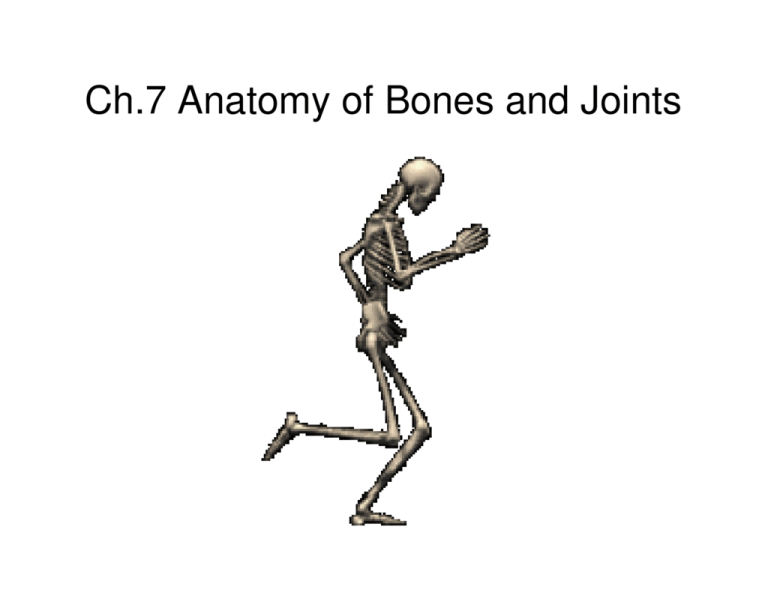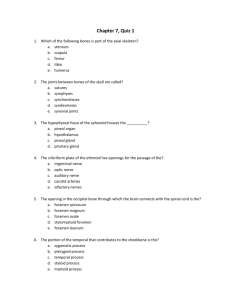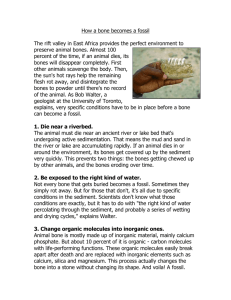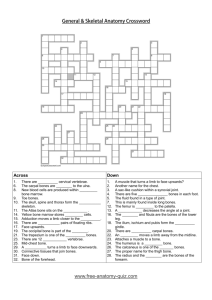Ch.7 Anatomy of Bones and Joints
advertisement

Ch.7 Anatomy of Bones and Joints General Considerations of Bones • 206 bones in adult skeleton • 270 at birth, bones fuse over time • Terminology – Articulate-bones joined or connected together – Paired bones • Of the same type located on the R/L side of the body (arm and legs) – Unpaired bones • Located on the midline of the body (vertebrae) Bone Markings • Surface features of bones: bulges, depressions, and holes that serve as: – Joint surfaces – Sites of attachment for muscles, ligaments, tendons – Passages for blood vessels and nerves Muscle attachment Joint surfaces Vessel passage Bone Markings (Surface Features) Table 5-1 General elevations & projections: process ramus Markings for articulations: head condyle facet Bone Markings (Surface Features) Processes for attachment: trochanter (femur only) tuberosity Transverse tubercle process epicondyle crest line spinous process (vertebrae only) transverse process (vertebrae only) Spinous process Bone Markings (Surface Features) Depressions: fossa sulcus Spinous process Transverse process Openings: foramen (canal) meatus fissure sinus Bone Markings • Two types of bone markings: – Projections (aka processes) that grow out from the bone – Depressions or cavities that indent the bone Joint Projections • 1) Condyle: Rounded articular projection Condyle Joint Projections • 2) Head: bony expansion on a narrow neck • 3) Facet: smooth, nearly flat articular surface Head Condyle Joint Projections • 4) Ramus: Armlike bar of bone Ligament/Tendon Projections 1) Crest: Narrow ridge of bone (Line: smaller than a crest) 2) Epicondyle: Raised area on or above a condyle ULNA 3) Tubercle: Small rounded projection 4) Tuberosity: large rounded or roughened projection 5) Trochanter: very large, blunt projection (only on femur) Proximal Tibia Ligament/Tendon Projections 6) Spine: Sharp, pointed projection Thoracic Vertebrae Depressions • Allow blood vessels or nerves to pass through. 1) Meatus: Canal or tube Depressions 2) Fossa: shallow basin 3) Fissure: narrow, slitlike opening Depressions 4) Sinus: Cavity within a bone; filled with air and lined with mucous membranes 5) Foramen: Round or oval opening Foramen Magnum Depressions 6) Sulcus, Groove or Furrow: a shallow depression Spinous process Foramen Transverse process Tuberosity Crest Bone Markings (Surface Features) Divisions of the Skeleton • Axial Skeleton – – – – – Skull Vertebral column Thorax (chest) Auditory ossicles Hyoid bone • Appendicular Skeleton – Limbs – Girdles (pectoral and pelvic) Skull • Composed of 22 bones – Bones are joined by sutures (fixed, non-movable joints) – Only the mandible is attached by a freely movable joint • Cranium: protects the brain – 8 bones in contact with brain and/or meninges • Frontal, parietal (2), occipital, temporal (2), sphenoid, ethmoid • Facial bones protect the sensory organs and serve as muscle attachment sites – The 14 facial bones, no contact with brain or meninges • Auditory ossicles that function in hearing, are located inside the temporal bones • Hyoid Bone Cranial Bones 8 Cranial Bones 1 x Frontal 2 x Parietal 1 x Occipital 2 x Temporal 1 x Sphenoid 1 x Ethmoid Frontal Bone • Forms forehead, roof of the cranium and orbits of eyes • Supraorbital foramen • Supraorbital margin • Coronal suture Parietal Bone • Roof of the cranium • Bordered by 4 sutures – – – – Coronal Sagittal Lambdoid Squamous Occipital Bone • Back of the skull • Foramen magnum – Spinal cord, verves, and blood vessels • Occipital condyle – Articulation with atlas • External occipital protuberance – Attachment of ligamentum nuchae (keeps head erected) • Nuchal line – Points of attachment for neck muscles Temporal Bone • Right & left; forms temple, cheek, ear openings • Houses middle and inner ear – – – – Zygomatic process Mastoid process Styloid process External Auditory meatus – Mandibular fossa – Squamous suture Temporal Bone • Zygomatic process • Forms bridge with zygomatic bone across the skul • Mandibular fossa – Mandible articulate with skull • Styloid process – Attachment site for 3 muscles: tongue, pharynx, and hyoid bone • External auditory meatus – Transmits sound waves toward eardrum • Mastoid process – Attachment for muscle that move the head Sphenoid Bone • Bat shaped • All skull bones connected to it – Sella turcica: depression for pituitary gland (hypophyseal fossa) Sphenoid Bone Sphenoid Bone • Greater wing • Lesser wing • Optic foramen – Passage of the optic nerve • Foramen rotundum and ovale – Trigeminal nerve Ethmoid Bone • Anterior to shenoid • Bony area between nasal cavity and orbits – Crista galli • Attachment for dura matter – Cribriform plate with olfactory foramina •Perpendicular plate forms nasal septum •Nasal conchae: Turbunates in the lateral wall of nasal caviy Sutures • Coronal Suture: between the frontal and parietal bones • Sagittal Suture: between right and left parietal bones • Lambdoidal Suture: between the parietal and occipital bones • Squamous Suture: between temporal and parietal bones Fontanels • Fusion of the cranial bones is not complete at birth • Space between the bones remains • Anterior “soft spot” closes at 18 months • Posterior (Occipital): triangular, closes at 2 – 3 months • Anteriolateral (Sphenoidal): at 2 temples, closes at 2 – 3 months • Posterolateral (Mastoidal): 2 behind ears, closes at 1 year Baby Skulls Baby Skull Facial Bones • 14 Facial Bones – Nasal Bones (2) – Inferior nasal canchae (2) – Lacrimal (2) – Vomer (1) – Zygomatic (2) – Maxillae (2) (pl.) • Maxilla (sing.) – Palatine (2) – Mandible (1) Nasal Bones • Small rectangular bones • Form bridge of the nose Inferior Nasal Conchae • Thin, curved bones attached to lateral wall of nasal cavity • Different from superior and middle conchae Lacrimal Bones • Form medial wall of each eye socket • Lacrimal groove (canal) drains tears into nasal cavity Vomer • Inferior half of the nasal cavity • Joints with the perpendicular plate of ethmoid to form nasal septum Zygomatic Bones • Forms the cheekbone and part of lateral orbital wall • Zygomatic Arch = zygomatic bone + zygomatic process of temporal bone Palatine Bones • Forms back roof of mouth and floor of nose • Horizontal plates form posterior portion of hard palate • Vertical portion form the lateral wall of nasal cavity Maxillae • Paired bones that form the upper jaw and face – Alveolar processes • Contain teeth – Palatine processes • Part of hard palate – Infraorbital foramen • Infraorbital nerve – Maxillary sinuses • Paranasal sinuses Mandible Mandibular notch • Lower jaw bone; largest bone of face • Only moveable – Body - forms the chin – Ramus- projects upward – Mandibular condyle, mandibular notch and coronoid process • Joint with temporal bone – Mental foramen • Mental nerve – Mandibular foramen • Nerve to mandibular teeth – Alveolar margin and process • Contain teeth Angle Hyoid Bone • • • • U-shaped bone In neck At base of tongue Only bone in body that does NOT articulate with another bone • Suspended from styloid process by muscles and ligaments Cranial Sinuses • 4 sets of cavities within the cranium • Resonance chambers for voice • Decrease weight of skull • Lined with mucous membrane Cranial Sinuses • Frontal sinuses (2): above eyebrows, open into nasal cavity • Ethmoid sinuses (2): between the eyes • Spenoidal sinus (1): posterior to ethmoidal sinus, opens into nasopharynx • Maxillary sinus (2): on either side of the nose, opens into the lateral wall of the nasal cavity Auditory Ossicles • 3 tiny bones form a chain in each middle ear cavity • Transmit sound waves from eardrum to the receptors of the inner ear Vertebral Column • Supports trunk and neck • Protects spinal cord • Multiple joint spaces allow for bending and twisting • 33 vertebrae, fibrocartilage disks between them Spinal Curvatures • Allow for resilience and spring for walking • Thoracic: present at birth • Sacral: bow back • Cervical: begins at 3 months when infant first begins to lift head • Lumbar: begins when child first walks Spinal Curvatures Abnormal Spinal Curvatures • Result from diseases, posture, paralysis, or congenital defects • Scoliosis (lateral) from lack of proper development of one vertebrae • Kyphosis (exaggerated thoracic curve) from osteoporosis • Lordosis (exaggerated lumber curve) from weak abdominal muscles Scoliosis Kyphosis Lordosis The woman on the right exhibits lordosis Vertebral Sections • Five types – 7 cervical in the neck – 12 thoracic in the chest – 5 lumbar in lower back – 5 sacral fused into sacrum – 4 coccygeal fused into coccyx Intervertebral Disc • • • • Outer fibrocartilage disk Gelatinous center Has high water content Normal disc is so strong that it can be damaged only be extreme forces • A normal, healthy disc is one of the strongest parts of the spine General Structure of Vertebra • Body • Vertebral foramen • Vertebral (neural) arch • Processes – Spinous – Transverse – Articular (superior and inferior) Cervical Vertebrae (C1-C7) • Smallest body, larger foramen • Transverse processes with foramen (vertebral arteries) • Forked (bifid) spinous process • C7 has the longest spinous proces Atlas and Axis (C1 and C2) • Atlas (C1) – Supports the skull – Has no body, ring shaped – Large faced (articulation with occipital bone) – Allows nodding of head “yes” • Axis (C2) – Dens (odontoid process) fits in the foramen of the atlas – Allows rotation of head: “no” Thoracic Vertebrae (T1-T12) • Larger body • Long pointed spinous process • Articulate with ribs • Coastal facets at ends of transverse processes • Thoracic area is stable and less susceptible for injuries Lumbar Vertebrae (L1-L5) • Large, heavy body for support • Short, horizontal spinous process • Lumbar area is the most prone to injuries Sacrum and Coccyx http://www.coccyx.org/whatisit/normal.htm Sacrum • Triangular shape • 5 sacral vertebrae fuse by age of 26 • Articulate with pelvic girdle (sacroiliac joint) • Anterior surface – Sacral foramina • Posterior surface – Superior articulate surface – Spinal processes fused to form median sacral crest – Posterior sacral foramina – Sacral canal ends as sacral hiatus Spina Bifida • 3rd week of pregnancy vertebral arches form around the spinal cord • Spina bifida-incomplete closure of the spinal column during pregnancy – Creates an opening, or lesion that damages the nerves and causes paralysis Coccyx • Tail bone • Single, small, triangular bone • 3-5 small vertebrae fused by age of 30 Thoracic Cavity 12 Pairs of Ribs, 12 Thoracic Vertebrae and Sternum Function • Protect and support heart and lungs • Supports bones of pectoral girdle • Plays leading role in respiration • Ribs and sternum aid in RBC formation Ribs • 12 pairs • Vertebrosternal (True ribs #1-7) attach to sternum with hyaline cartilage • Vertebrochondrial (False ribs #8-10) • Floating (Vertebral #11-12) Sternum • Breastbone • Resembles a sword • 3 parts – Manubrium -handle, articulates with acromion end of clavicle and 1st rib • Jugular notch • Clavical notch – Body- blade, notched for 1st 7 costal cartilages – Xiphoid process-: tip, attachment site for diaphragm Appendicular Skeleton • Pectoral (Shoulder) girdle • Pelvic girdle • Appendages – Upper limbs – Lower limbs Pectoral Girdle • Girdle=encircles, complete ring – Clavicles (2): collar bones – Scapulas (2): shoulder blades • These bones allow the upper limb to have exceptionally free movement Clavicle • Collar bone • S-shaped • Articulate with – Proximally manubrium – Distally- acromium of scapula • Sternal end is rounded-acromial end is flatten Clavicle Scapula • Spine- bony ridge divides posterior surface • Acromial process- articulation w/clavicle • Coracoid proces (hook) muscle attachment • Glenoid fossa (cavity) – connects w/ the head of humerus • Axillary (lateral) border • Inferior and superior angle • Vertebral border • Superior border Superior angle Superior border Upper Limb • 30 bones per limb • Humerus (arm,brahium) • Forearm (antebrachium) – Radius-thumb side – Ulna-little finger side • Carpus=wrist (8) • Hand (manus) (19) – Metacarpals (palm) (5) – Phalanges in the fingers(14) Humerus • Head –articulate w/ scapula • Greater, lesser tubercle, and deltoid tuberosity -muscle attachments • Intertubercular groove-holds biseps • Capitulum-articulates w/ radius • Trochlea-articulate w/ ulna • Anatomical and surgical neck • Lateral and medial epicondyle attachment for forearm muscles • Olecranon fossa -depression where ulna fits with humerus to form hinged joint Surgical neck Arm and Forearm Tennis Elbow • Inflammation of tissues surrounding the lateral epicondyle of humerus (epycondylitis) • 6 muscles that control movement of the hand attach in this region and repeated contractions irritate the attachments Radius • Radius (rotates around the ulna) – Head- articulate w/capitulum – Redial tuberosity attachment for the biseps – Styloid process attachment for ligaments of the wrist Ulna • Olecranon process – fits into olecranon fossa of humerus • Radial notch– Head of the radius fits • Head and styloid process – at distal end – ligament attachments • Interosseous membrane – Ligament attaches radius to ulna along the crest The Wrist and Hand • Carpals -wrist – Two rows of 8 bones • Matacarpals -palm • Phalanges -fingers Carpal Tunnel Syndrome • Bone and ligaments form carpal tunnel on the anterior site of the wrist • Median nerve gets compressed as result of inflammation associated with overuse or trauma • Pressure on the nerve causes burning and numbness of the hand Pelvic Girdle • Coxal (Hip) bones – Ilium – Ischium – Pubic bone • Sacrum • The total weight of the upper body rests on the pelvis • Protects several organs – Reproductive organs – Urinary bladder – Part of the large intestine Coxal (Hip) Bone • • Acetabulum (hip socket) Ilium – Iliac crest -muscle attachment, forms prominence of hips • Pubis – Obturator foramen- largest opening in the body, between pubis and ischium, passage for blood vessels, nerves, and tendons – Pubic symphysis -midline when two pubic bones meet – Pubic arch - V-shaped formed by inferior pubic rami • Ischium – Ischium tuberosity bears the body weight when sitting, strongest part of coxal bones Gender Differences of the Pelvis • Female – Bones lighter, thinner, and smoother – Pelvic inlet wider and more oval – Pubic arch more than 900 – Ischial tuberosities farther appart – Ilium more flared, giving female broader hips • Male – Heavier bones, markings more prominent – Pelvic inlet heart shaped – Pelvic cavity narrow, deep, and funnel shaped – Pelvic arch less than 900 Lower Extremity • Femoral bone= thigh (femur) • Patella (knee cap) • Crural =leg – Tibia-shin bone – Fibula • Pedal =foot bones – Tarsals (ankle) – Metatarsals (sole) – Phalanges (toes) Femur • Head – Fits into acetabulum of coxal bone • Neck – Offsets thigh from hip joint for easy In movement – Muscle attachment • Lesser and greater trochanter – Muscle attachment (gluteus and hip m.) • Medial and lateral condyle – Articulate with tibia • Gluteal tuberosity – Attachment for gluteal muscles • Patellar surface – Articulates with patella Patella and Tibia • Tibia: strong weightbearing, on the medial side – Two flat articulated surfaces w/ femur: medial and lateral condyle – Tibial tuberosity • Can be palpated below the patella (attachment for patellar ligaments) – Tibial malleosis • Forms medial side of ankle joint – Anterior crest • Sharp edge on the shin Patella Fibula • Lateral bone that helps stabilize the ankle, not weight bearing • Head is proximal – Articulates with tibia • Lateral malleolus – Forms lateral bulge of ankle – Attachment for ligaments The Ankle and Foot • Tarsal bone: load-bearing bones of the ankle • The bony arches transfer weight from the heels to the toes and allow the foot to conform to many different positions The Ankle and Foot • Body relies on feet for balance, shock absorption, and support • Soft yet firm support of all of the bones and arches of each foot is necessary for spine and nervous system function • Proper weight distribution and support with spinal pelvic stabilizers allows the feet to take extra strain off the pelvis and spine Arches of the Foot Tarsals • Calcaneus (Ca) – Forms the heal • Talus (T) is most superior tarsal bone – Forms ankle joint with tibia and fibula • Navicular (N) boat shaped • Distal row of cuneiformed (wedged shaped) bones – Cuboid (C) – Medial (1st) cuneiform (Cm) – Intermediate (2nd) cuneiform (Ci) – Lateral (3rd) cuneiform (Cl) MILC No Thanks Cow The Foot • Similar in name and arrangement to hand • Metacarpals (5) sole – 1st is proximal to great toe • Phalanges (14) toes – 2 in great toe • Proximal and distal – 3 in all other toes • Proximal, middle, distal









